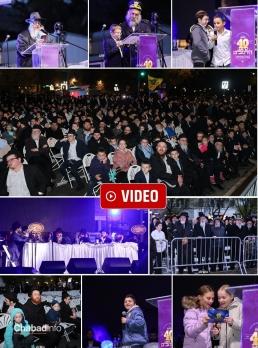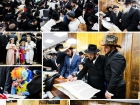Scoop Into “Chassidic Fashion”
He goes on to describe other “unfortunate” ways people may try to differentiate themselves. “They put in modern things,” he says. Some men will want different-colored buttonholes or will have their coats shorter than usual, coming up over the knee • Full Article
To an outsider walking past Chabad Lubavitch world headquarters in Crown Heights, Brooklyn, it might be difficult to distinguish any differences in the way the herds of Hasidic men lingering outside 770 Eastern Parkway are dressed.
But not everyone is wearing the same exact white shirt, black suit, and black hat. And on Shabbat, there are subtle differences between the type of shtreimel (round furry hat), or kapoteh (black overcoat) worn by different individuals.
But the idea is that these Hasidim look generally, well, the same.
“It’s a uniform,” says Israel Shemtov, a distinguished tailor and Lubavitcher.
As feisty as he is famed, the five-foot-tall Shemtov is know as the “Red Devil.” He runs an old school tailoring shop in Crown Heights where he makes kapotehs for men in the community. Shemtov says that clothing should be modest, and nothing to boast about.
“A person should not feel that he is something special,” he says. “The clothing doesn’t make the man, the man makes the clothing.”
Shemtov denies that Haredi (ultra-Orthodox) men’s fashion should have any room for self-expression, though almost automatically he can list the nuances in how Haredim dress, the slight details that differentiate various Haredi groups. If you know what to look for, seeming minutia to the untrained eye — the brim of a hat, the length of a suit jacket, the buttons on a shirt — are the minor distinctions that set an individual apart.
A “uniform,” and especially a religious one, serves two main purposes, according to Solomon Freundlich, a Lubavitcher and event organizer in the Crown Heights community.
“First of all, if you’re wearing it [the religious uniform] you won’t go to a place where you’re not supposed to be,” he says. “You don’t go to a non-kosher restaurant or a movie theater wearing a kapoteh.”
Freundlich says that the clothing makes one aware of and feel that they’re a part of a particular group, with its own set of rules, customs, and of course, dress. For instance, he says, oftentimes when the newly observant first become religious, they’ll start with the outfit.
In addition to representing affiliation within a group, the uniform is symbolic of a deeper purpose, Freundlich adds.
“I believe that Hasidic deeds of kindness, or helping people, or studying the Rebbe’s Torah are more important than dress,” he says.
Freundlich believes that a person’s clothes should not distinguish them so much as their deeds.
That said, certain stylistic details may represent a person’s level of observance.
For instance, says Shemtov, someone in a rabbinical position might wear a Prince Albert suit, which looks like an evening coat, except the tuxedo would be cut away in the front and has two pleats on the sides.
Now here’s where there may be some other differentiating details: “Those can be made out of wool, or any other fabric,” says Shemtov. “But preferably these Hasidim would wear silk, that the whole garment be made out of real silk.”
And sometimes, a kapoteh will have paisleys embroidered into the muted black of the garment, he says. The idea is that on Shabbat and holidays, people dress their very best, wearing the highest quality material, such as silk. And while clothes should be modest, they still cost a pretty penny. Haredi men’s suits and coats could cost up to $20,000 or $30,000.
“It has a lot to do with the fabric,” Shemtov says. “I can use anything from $20 a yard to $4,000 a yard.”
He goes on to describe other “unfortunate” ways people may try to differentiate themselves.
“They put in modern things,” he says.
Some men will want different-colored buttonholes or will have their coats shorter than usual, coming up over the knee.
“That’s extremely short, which is nearly defeating the purpose of that whole garment to be a Shabbos garment. It takes away from the real Shabbos look or the religious look,” he says.
On the flip side, Shemtov’s clients have also requested their coats to be floor length, or dark blue instead of black, which he says is “weird.”
“Guys who play around with the kapoteh, I despise it,” he says. “It’s a holy article. Every single kapoteh I make is basically the same exact thing, except for differences in quality, like fabric.”
What goes under the kapoteh, however, is a different story.
“Put it this way, when I was a teenager, I started sending my shirts to the cleaner, and I wore only white shirts,” says Lubavitcher Zalmy Mochkin. “For the guys who were into fashion around that age, I like to say when I would go to pick up my shirts from the cleaner, I knew my white shirts from everyone else’s.”
Mochkin describes those minor differentiating details in the form of two buttons on the collar, or two buttons on the sleeve, or custom stitching somewhere.
He remembers as a child going into Manhattan on Friday afternoons with other Chabad boys to meet businessmen and put phylacteries on them.
“For certain people, the dream location used to be the fashion district,” he says. “We saw the world and were exposed at a young age.”
Everyone learned to dress in their own ways, says Mochkin, whether it was wearing their pants cuffed or straight, clipping their beard below the chin, tucking it under their shirt (Lubavitchers don’t trim their beards), or having different color lining in their suit jacket.
“It might seem like a lot of different tastes,” says Mochkin. “But when you go deeper, it’s not just about different tastes. Everyone has little uniquenesses, and they’re spread out.”
363
Join ChabadInfo's News Roundup and alerts for the HOTTEST Chabad news and updates!










































